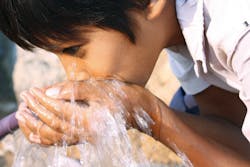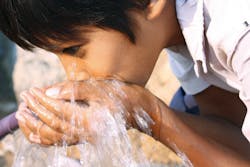Global Water Outlook
Top 3 trends shaping today’s most valuable resource
By Gilad Cohen
In 2018, we saw yet again how weather patterns can affect access to our most valuable resource — water. According to the United Nations (UN) Intergovernmental Panel on Climate Change report, the future of water is daunting. Many areas around the world will suffer from a lack of water due to high population growth and geopolitical tensions in those areas. If we continue to use water at the current rate, we will face severe scarcity at unprecedented levels. In fact, UN projections show that by 2020 about 30 to 40 percent of the world will experience water scarcity; and by 2025, two-thirds of the world’s population will be living in water-stressed regions.
As drought conditions continue this year, it’s no surprise that we will need to actively seek alternative water sources in order to meet municipal water demand. Let’s take a look at the top trends that will shape the water economy this year.
Meeting Water Needs with Less Snowpack
When it comes to the winter weather forecast for the 2018-2019 season, the United States’ National Oceanic and Atmospheric Administration (NOAA) has reported that there is a 70 percent chance that we will have an El Niño year. This means that there will be another warmer-than-average winter across the U.S.
Based on an El Niño winter, the Pacific Northwest and the Northern Rockies will see below average to equal chances of precipitation from October through December. However, Colorado, parts of Utah, and the Southern Rockies are all expected to see above-average precipitation for the start of the season while New England is expected to see average precipitation throughout the start of the winter.
As water scarcity becomes a new reality for more countries, governments should consider new water conservation measures to help preserve natural water sources.
A snow deficit spells trouble for water managers and communities that depend on melt water to fill reservoirs. Early predictions indicate that California and Arizona may again see less water in reservoirs to meet the basic needs of the population. Numerous other national ecosystems that depend on melting snow packs for water will also mean more competition for the same resources and increased water shortages. As such, states across the U.S. will need to look for alternative water solutions.
Seawater desalination, for example, provides municipalities access to clean, high-quality water from the ocean. Seawater reverse osmosis (SWRO) desalination solutions are cost-effective and have reduced energy use, which means they create a smaller carbon footprint.
A snow deficit spells trouble for water managers and communities that depend on melt water to fill reservoirs.
Creating Controlled Water Demand
Cape Town’s experiences of nearing ‘Day Zero’ may become a new reality for many urban regions in 2019. The drought-stricken city has now pushed Day Zero to later this year due to the above-average rainfall South Africa saw in mid-2018.
There are key lessons the global population can take away from Cape Town’s experience. It was truly a community effort that helped the city bypass its worst water shortage in history after a two-year drought triggered by El Niño. Residents abided by stringent consumption restrictions of 50 liters of water per person per day. As water scarcity becomes a new reality for more countries, governments should consider new water conservation measures to help preserve natural water sources.
Another alternative can be water infrastructure solutions; however, these take time to build and implement. Therefore, governments should examine solutions that can be integrated with existing water systems to help manage water usage within communities.
By retrofitting existing systems to reuse wastewater, communities can have access to clean water that is both sustainable and safe, while also being more affordable to set up and implement. Wastewater can also be treated to levels higher than current tap water — a major benefit for many communities. Reusing water also allows communities to control mandates with an eco-friendly solution that does not deplete other sources.
Municipalities are becoming increasingly conscious of the impact water chemicals have on the environment, opting to implement more environmentally friendly solutions to meet growing demand.
Implementing Eco-Friendly Water Solutions
Municipalities are becoming increasingly conscious of the impact water chemicals have on the environment and are opting to implement more environmentally friendly solutions to meet growing demand. Chemicals like chloramine, a combination of chlorine and ammonia, can be quite toxic to the environment. In fact, when used as a disinfectant in water, chloramine can be fatal to fish and frogs. The California red-legged frog is now classified as “threatened” by the U.S. Fish and Wildlife Service due to chloramine present in water supplies.
When used during reuse, chloramine protects the RO membrane from biofouling caused by the organic materials that exist in wastewater, but it also creates two additional side effects: increased energy consumption (possibly as much as 50 percent) and the formation of disinfection byproducts that can have detrimental effects on humans. Chloramine can form N-Nitrosodimethylamine (NDMA), which is an organic contaminant suspected to be carcinogenic. With eco-friendly water solutions, no chemicals are used in the process to clean or disinfect the water, which protects everyone from harmful chemical effects.
Municipalities and governmental bodies have much to prepare for this year as they face water shortages yet again. As such, it’s critical that they plan well in advance and look for alternative solutions to complement natural water sources and meet growing water demands caused by increased populations as well as emerging industrial projects. Water managers need a keen understanding of solutions available and should consider implementation efforts before it’s too late.
About the Author: Gilad Cohen is CEO of IDE Americas, a water treatment solutions leader specializing in the development, engineering, construction and operation of enhanced desalination and industrial water treatment plants. Prior to joining IDE in 2009, Cohen was senior consultant for one of Israel’s leading management consulting firms on business competitive and corporate strategy. He holds a B.Sc. in computer sciences and an MBA, both from the Hebrew University in Jerusalem.
Circle No. 238 on Reader Service Card




